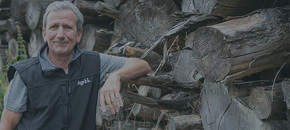
Back to the future with northern farm AD
Case Study - 23.07.15
Booth brothers get to grips with AD feedstock
Anaerobic digestion plants can be tricky beasts to feed, as the Booth brothers in West Yorkshire have found out. But through trial and error, and working with Agrii, they’re building important intelligence for other farmers to maximise their own AD plants.
Charlie and Alaric’s plant at Smeathalls Farm, Knottingley, is one of the first major AD plants to be commissioned in the county, and took 15 years of hard work to get off the ground.
The £3 million+, 499kWe two-stage Snow Leopard plant has four vessels connected together by a complex pumping and control system, piping methane to a massive generator.
In its first nine months the plant delivered almost 1.5 million KWh to the electricity grid from only 3000t of feedstock.
But things weren’t plain sailing to start with as the brothers wrestled to find the right feedstock for the plant. Luckily, they also host Agrii’s Brotherton iFarm, so their experience in running trials and collaborating with others has proved invaluable.

Teething problems
The plant was designed to run off 120ha of home-grown feedstock (the farm is 160ha), including wholecrop cereals, maize and grass silages, energy beet, cereal and OSR straw, as well as mention cattle, poultry and pig manure.
But finding what the AD plant runs well on, and matching this to what the farm can comfortably produce, has not been easy.
“With two stages, four tanks and a reliance on bugs, it’s just like a cow’s stomach,” explains Charlie. “So just like a cow you have to feed it the right diet to keep it producing efficiently. And, just like a cow, it can get sick and cause you all sorts of problems if you don’t keep feeding it right.
“Being designed for Germany, the plant is happiest living on maize – which we can’t grow on most of our land up here. We originally understood we could use up to 70% grass silage, which we can grow very well, and this would have been ideal.
“So we put in 200 acres [80ha] of two year leys to supply it, only to find that too much grass caused the whole thing to lock-up solid, shutting down completely and taking a lot of effort to reinstate.”
Matching farm production to the AD plant
“Having got this particular T-shirt, we’ve since been experimenting with a range of feedstocks matched to our land, with Philip Marr [the farm’s AD forage and rye consultant], our agronomist Sam Patchett, and the Agrii team.
“At the moment we’re running on around 60% energy beet, 35% grass silage and 5% chicken litter (for the extra nitrogen), topping the plant up every couple of days. Touch wood, things seem to be running well with a good steady output of the right gas mix,” says Charlie.
With only 49-53ha of land light enough to grow either beet or maize however, this mix is far from ideal for the farm. So it is being adapted over the coming year with the inclusion of wholecrop and forage rye.
Building on experience
Having experienced people, including the Agrii team, on hand has been vital to figuring out what suits the AD plant best.
“Winter rye has proved valuable for AD further south, so we’ve grown 150 acres on the farm’s heaviest ground this season, harvesting over 20t/acre at the milky ripe stage in early July,” says Philip Marr.
“That’s at least as much as several cuts of grass – not to mention at a lower cost per tonne and with a methane value equivalent to maize.
“This year we’re growing 40 acres of energy beet and 86 acres of maize silage on the light land. At the same time, we’re experimenting with double cropping on just under half the maize ground.
“We put in forage rye last autumn and harvested around 10t/acre at the end of April, just in time to drill the maize. Harvesting the rye this early means we’ve had to sacrifice some of its yield, just as we’ll get less maize silage from not drilling until mid-May.
“But two crops should give us more energy from the year’s cropping than we would have got from wholecrop rye or maize alone.
Important lessons for successful AD plants
“There’s a lot we need to learn about both growing and using rye and beet as well as maize for energy production,” continues Philip.
“For instance, our iFarm trial work is showing big differences in the speed of development of rye varieties, the consistency of later-maturing maize varieties and the tare content of beet varieties, all of which can make a huge difference to crop productivity.
“We’ve also got to understand how best to integrate energy crops into the rotation to fit other requirements, like black-grass control; how to produce them as economically as possible within existing resources and workloads; and where and how to most effectively utilise the AD digestate that can be a valuable fertiliser but carries considerable handling and spreading costs.
“Far more people putting-up plants today need to really think through these and other agronomic and management implications that, I have no doubt, will be the difference between long-term success and failure of farm AD.”
Having first looked into building an AD plant in the early 2000s when wheat prices were very low, the Booth brothers hoped to generate a more reliable income than directly from farming. Having successfully discovered how to maximise their AD plant with Agrii’s help, this particular income stream now looks more stable.
Join Our Community

Agrii X
We love engaging with clients and partners. Give us a follow and let's share stories for the community.

Agrii Instagram
A picture paints a thousand words. Follow us on Instagram to see what we are up to.

Agrii Facebook
Follow us on the worlds biggest social media site for the latest news and events straight to your feed.

Agrii LinkedIn
If you are all about the business, connect with us on LinkedIn to build your network
Stay In Touch

Journal Sign-Up
Receive email updates on topical news and information from around Agrii and UK Farming.

Listen To Our Podcasts
Listen to the Tramlines Podcast. Fortnightly chat about agriculture and trials with your host Tony Smith.

Agrii Insights
Read essential agri intelligence for profitable farming.

Find an Event
Join us for our upcoming events and tours.



